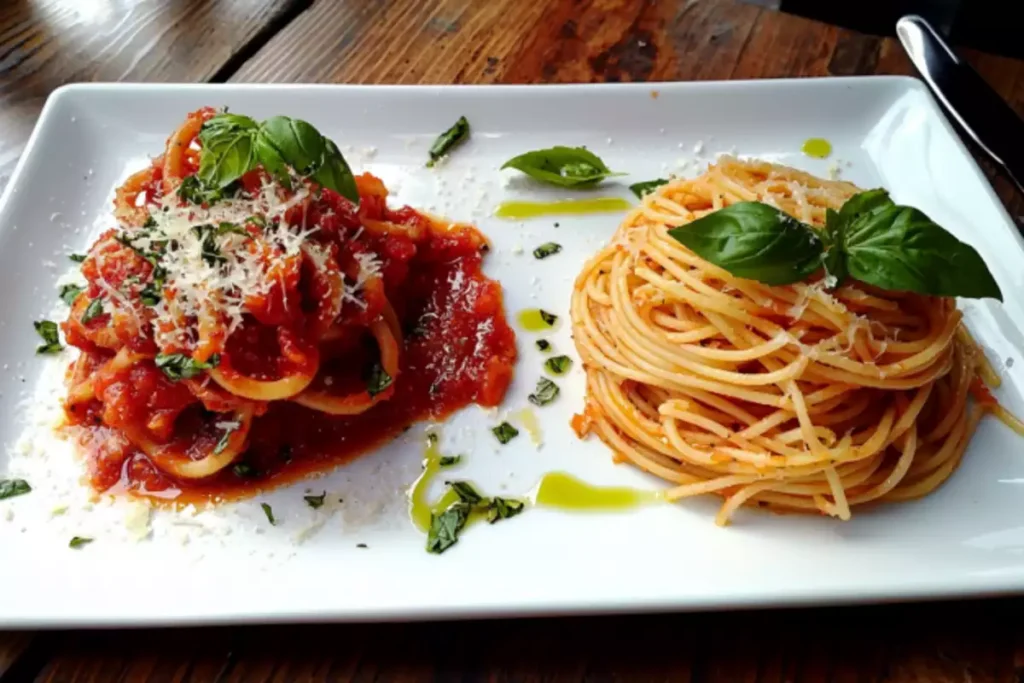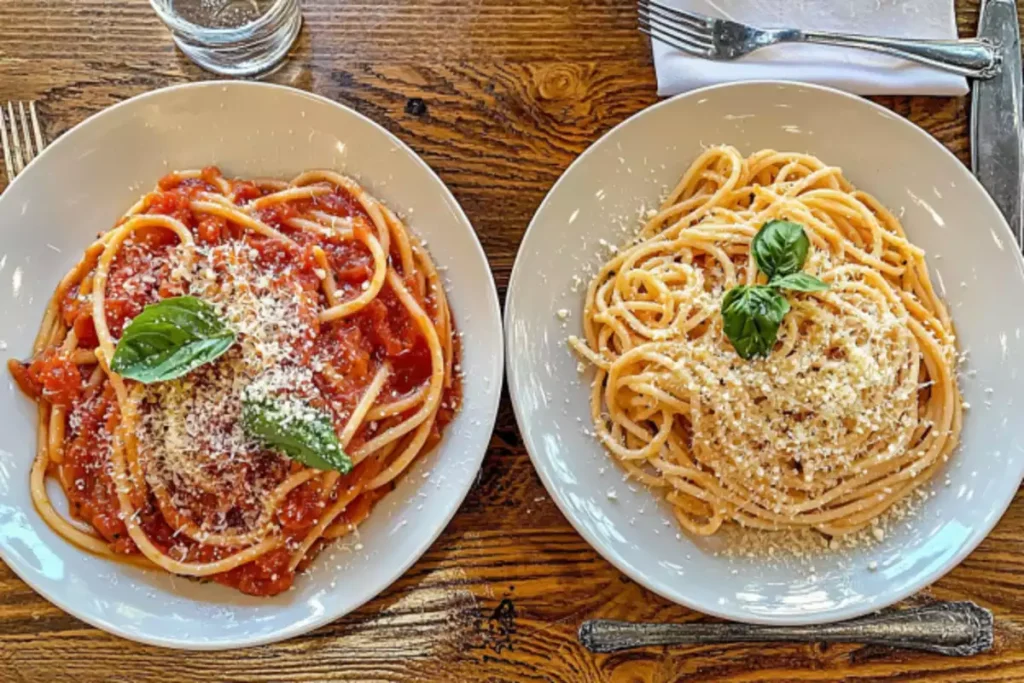
When it comes to Italian cuisine, pasta reigns supreme. Among the countless varieties of pasta, bucatini and spaghetti are two of the most popular and widely used. Though they may appear similar at first glance, these two types of pasta offer unique textures, flavors, and uses. So, what’s the difference between bucatini and spaghetti? Let’s dive into their characteristics, uses, and the cultural influences that make them unique.
Introduction to Italian Pasta Varieties
Italian cuisine is celebrated for its pasta diversity, with over 350 types of pasta crafted to suit different sauces, ingredients, and occasions. Bucatini and spaghetti are long, cylindrical pastas often confused for one another. However, each offers a distinct experience that can elevate your dish when paired thoughtfully.
What Is Bucatini?
Bucatini, derived from the Italian word buco meaning “hole,” is a tubular pasta. Its hollow center is its most distinguishing feature, making it both functional and versatile in capturing sauces.
Characteristics of Bucatini
- Hollow Structure: Bucatini’s hollow center allows it to soak up rich and creamy sauces.
- Firm Texture: Slightly thicker than spaghetti, bucatini delivers a heartier bite.
- Traditional Length: Typically 10-12 inches long, similar to spaghetti in appearance but larger in diameter.
Popular Dishes Featuring Bucatini
Bucatini shines in recipes that emphasize robust, flavorful sauces.
- Bucatini all’Amatriciana: A classic Roman dish with guanciale, tomatoes, and Pecorino Romano cheese.
- Creamy Seafood Bucatini: Ideal for seafood-based sauces, allowing the hollow pasta to trap delicate flavors.
- Bucatini with Cacio e Pepe: A simple yet bold combination of Pecorino cheese and black pepper.
Spaghetti: A Global Icon
Spaghetti needs no introduction, as it’s arguably the most recognized type of pasta worldwide. Thin, round, and solid, it has been a cornerstone of Italian cuisine for centuries.
Key Features of Spaghetti
- Smooth and Versatile: Spaghetti clings to sauces evenly, making it ideal for various recipes.
- Delicate Structure: Thinner than bucatini, it pairs well with light and oil-based sauces.
- Ease of Use: Its simple shape and quick cooking time make it perfect for everyday meals.
Classic Recipes Using Spaghetti
Spaghetti pairs well with a variety of flavors, from simple to complex.
- Spaghetti Carbonara: A creamy dish made with eggs, pancetta, and Parmesan cheese.
- Spaghetti Aglio e Olio: A quick and flavorful dish of garlic, olive oil, and chili flakes.
- Spaghetti Bolognese: Hearty and comforting with a rich meat sauce.
Comparing Bucatini and Spaghetti
Despite their similarities, bucatini and spaghetti differ significantly in structure, texture, and culinary application. Here’s how they compare:
1. Structure and Texture
- Bucatini: Features a hollow center, making it more substantial and capable of capturing sauces.
- Spaghetti: Solid and thinner, offering a smoother texture with no hollow interior.
2. Sauce Compatibility
- Bucatini: Best for hearty and creamy sauces that benefit from being absorbed inside the pasta.
- Spaghetti: Ideal for light or oil-based sauces that cling to its surface.
3. Cooking Time
- Bucatini: Requires more time to cook (10-13 minutes) due to its thickness.
- Spaghetti: Cooks faster, typically ready in 8-10 minutes.

Regional Influence on Pasta Choices
Pasta is deeply rooted in Italian regional cuisines. Understanding the cultural significance of each type enhances your appreciation for the dishes they inspire.
Bucatini in Lazio
Bucatini is a staple in Lazio, where it is the foundation of dishes like Bucatini all’Amatriciana. Its hollow design makes it perfect for sauces that are rich and bold.
Spaghetti’s Universal Appeal
Spaghetti is a symbol of Italian cuisine around the world, thanks to its simplicity and adaptability. From traditional Italian recipes to global fusion dishes, spaghetti’s versatility knows no bounds.
Cooking Tips for Perfect Results
Whether you’re making bucatini or spaghetti, the right techniques ensure a delicious result.
Tips for Bucatini
- Salt Generously: Bucatini absorbs flavors from the cooking water, so don’t skimp on salt.
- Use a Large Pot: Prevent breaking the long, thick noodles by giving them plenty of space to cook.
- Toss Immediately: Mix bucatini with sauce as soon as it’s drained to coat the pasta evenly.
Tips for Spaghetti
- Cook to Al Dente: Spaghetti’s delicate structure can overcook easily, so keep it firm to the bite.
- Save Pasta Water: Use starchy water to thicken sauces and help them adhere to the noodles.
- Twirl for Presentation: For an elegant look, twirl spaghetti into neat servings before plating.
Nutritional Insights
Both bucatini and spaghetti share similar nutritional profiles as they are made from durum wheat semolina. However, differences in shape and serving size can slightly affect their calorie and carbohydrate content.
Nutritional Comparison
- Calories: Bucatini may contain slightly more calories per serving due to its thickness.
- Carbohydrates: Both are rich in carbs, providing energy for your day.
- Protein: Whole-wheat options for both types offer higher protein and fiber content.
Healthier Options
- Opt for whole-grain bucatini or spaghetti for added fiber and nutrients.
- Gluten-free versions are available for those with dietary restrictions.
Wine Pairings for Pasta Perfection
Pairing wine with pasta elevates the dining experience. The choice of wine depends on the type of pasta and its sauce.
Best Wines for Bucatini
- Chianti or Montepulciano: Complements robust sauces like all’Amatriciana.
- Chardonnay: Pairs well with creamy seafood dishes.
Best Wines for Spaghetti
- Sauvignon Blanc: Perfect with garlic oil-based dishes.
- Pinot Noir: A balanced red wine for tomato-based sauces.
The Cultural Impact of Pasta
Pasta is more than just food in Italy; it’s a cultural emblem that tells a story of tradition and creativity. While bucatini is a local favorite in central Italy, spaghetti represents a universal language of comfort and joy, making it a bridge between cultures.
Conclusion: Choosing the Right Pasta
Understanding the differences between bucatini and spaghetti allows you to make the best choice for your recipes. Bucatini, with its hollow core, is ideal for hearty and creamy sauces, while spaghetti’s delicate structure suits lighter, oil-based sauces. Both are classics in their own right and deserve a place in every pasta lover’s repertoire.
So the next time you’re faced with the decision of which pasta to use, consider the sauce, occasion, and texture you want to achieve. With this knowledge, you’re well-equipped to create a memorable meal that showcases the best of Italian cuisine.